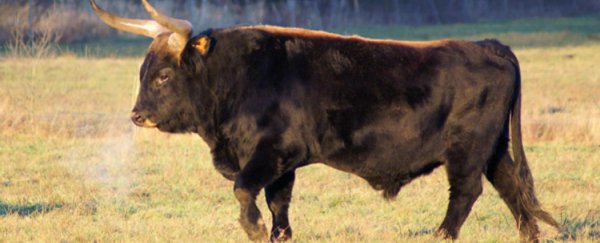So, back in the 1930s, scientists in Nazi Germany decided to bring a long-extinct species of wild ox back from the dead. The ox in question is the aurochs - an ancestor of domestic cattle, similar in its function of being able to sustain many people via its flesh, completely and utterly different in its capacity, and perhaps willingness, to be tamed. To be specific, the aurochs refused to be tamed.
Spread throughout Asia, Europe and North Africa, this large bovine could sometimes grow to be 180 cm tall at the shoulder and 700 kg in weight. Both the males and the females were crowned with a tremendous pair of horns that were elongated, thick and dangerously pointy at the end. These horns could stretch 80 cm in length and up to 20 cm in diameter.
It was these horns that ultimately led to the aurochs' downfall, as unrestricted hunting drove the numbers down to a single population in Europe. The last individuals reportedly died in the Jaktorów Forest of Poland in 1627.
According to Steven Morris at The Guardian, aurochs became an emblematic animal in the Teutonic mythology left behind by the ancient Germanic tribes - the Norsemen, Goths, Vandals, Burgundians, Franks, Angles, Saxons, and the like - whose descendants now occupy many regions of Europe. For this reason, the Nazis visualised a time where aurochs, or creatures just like them, would once again roam free across the verdant German countryside to be hunted at will.
German zoologist brothers Heinz and Lutz Heck set themselves to the task of 'recreating' the species by selectively breeding domestic cattle to look like them. The result came to be known as Heck cattle, and they sure did look magnificent. With large, sharp horns and a thick, shaggy pelt of black and gold, these were some handsome animals - some called them 'super cows' - and the breed has survived to this day. But certainly not because they're well-liked.
In 2009, British farmer Derek Gow transported a herd of 13 Heck cattle from Germany to his farm in Devon, England, to study, breed, and photograph them. While he managed to breed 20 more Heck cattle from those, he's now having to carry out the rather unfortunate deed of culling them to just six on account of their unbridled aggression.
He tells Morris at The Guardian:
"The ones we had to get rid of would just attack you any chance they could. They would try to kill anyone. Dealing with that was not a lot of fun at all. I have worked with a range of different animals from bison to deer and I have never come across anything like these. They are by far and away the most aggressive animals I have ever worked with. Some were perfectly calm and quiet and they are the ones we have kept. The others you could not go near.
"We made sure no one went near them so there were never any incidents. To get them into the trailer to get them off the farm we used a young and very athletic young man to stand on the ramp and they charged at him before he quickly jumped out the way."
How told Morris that when the Heck brothers were creating their aurochs replica, taking a little bit from this breed of cow and a little from that breed of cow, they inserted Spanish fighting cattle firmly into the mix "to give them the shape and ferocity they wanted". The Nazi officials approved the idea, because the more fierce and aggressive your hunting target, the more impressive the trophy.
Of course, it's not the animals' fault, and Gow regrets having to put a number of them down. He said he tried to rehome them but could not find any takers, but is determined to conserve them in any way he can. It's thought that there are about 2,000 individuals left in Europe. "As far as being a commercial breed is concerned, they have little value, but they are a significant animal from a conservation point of view," he told Morris.
Once again, said Gow, peace (on the farm) reigns supreme.
Source: The Guardian
